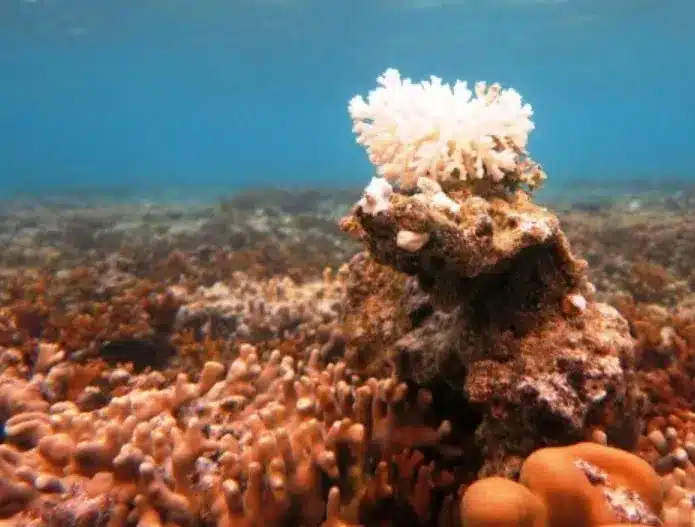What’s in today’s article?
● Why in News?
● What are Corals and coral reefs?
● What is the significance of corals?
● What is Coral bleaching?
● Fourth global bleaching event
Why in News?
As per the US National Oceanic and Atmospheric Administration (NOAA), the fourth global mass coral bleaching event has been triggered by extraordinary ocean temperatures.
What are Corals and coral reefs?
- Corals
- Corals are like underwater animals that stay in one place on the ocean floor. They have small tentacles to grab food from the water and bring it into their mouths.
- Each individual coral animal is known as a polyp and it lives in groups of hundreds to thousands of genetically identical polyps that form a colony.
- Types of corals
- Corals are largely classified as either hard coral or soft coral.
- Unlike soft corals, hard corals have stony skeletons made out of limestone that are produced by coral polyps.
- When polyps die, their skeletons are left behind and used as foundations for new polyps.
- Coral reefs
- It is the hard corals that are the architects of coral reefs — complex three-dimensional structures built up over thousands of years.
- Coral reefs, also referred to as rainforests of the sea, have existed on the Earth for nearly 450 million years.
- Australia’s Great Barrier Reef is the largest in the world, stretching across 2,028 kilometres.
What is the significance of corals?
- Biodiversity Hotspots
- Coral reefs are like bustling cities underwater, providing homes for a huge variety of marine life. They are like apartments for fish, crabs, and other creatures.
- E.g., the Great Barrier Reef contains over 400 coral species, 1,500 fish species, 4,000 mollusc species and six of the world’s seven sea turtle species.
- Protection
- Coral reefs can absorb up to 97% of the energy from waves, storms, and floods, which prevents loss of life, property damage, and soil erosion.
- Economic Value
- Coral reefs support industries like fishing and tourism, providing livelihoods for many people around the world.
- Tourists love to snorkel and dive among vibrant coral reefs.
- Medicine and Science
- Corals hold potential for new medicines and scientific discoveries. They have already contributed to treatments for diseases like cancer and arthritis.
- Carbon Cycling
- They play a role in the carbon cycle, helping to regulate the Earth’s climate by absorbing carbon dioxide from the atmosphere.
What is Coral bleaching?

- Symbiotic relationship between corals and zooxanthellae
- Most corals contain algae called zooxanthellae — they are plant-like organisms — in their tissues.
- Corals and zooxanthellae have a symbiotic relationship.
- Corals provide zooxanthellae a safe place to live.
- On the other hand, zooxanthellae provide oxygen and organic products of photosynthesis that help corals to grow and thrive.
- Zooxanthellae also give bright and unique colours to corals.
- Coral bleaching
- Corals are very sensitive to light and temperature and even a small change in their living conditions can stress them.
- When stressed, they expel zooxanthellae and turn entirely white. This is called coral bleaching.
- Coral bleaching doesn’t immediately lead to the death of corals. They rather go under more stress and are subject to mortality.
- Coral bleaching reduces the reproductivity of corals and makes them more vulnerable to fatal diseases.
- If the bleaching is not too severe, corals have been known to recover.
- Global mass bleaching of coral reefs
- Global mass bleaching of coral reefs is when significant coral bleaching is confirmed in the Atlantic, Indian and Pacific oceans.
- Such events are a relatively new phenomenon.
- The first one took place in 1998 in which 20% of the world’s reef areas suffered bleaching-level heat stress.
- The next two global bleaching events occurred in 2010 (35% of reefs affected) and between 2014 and 2017 (56% of reefs affected).
Fourth global bleaching event
- About
- NOAA has confirmed that the fourth global bleaching event is currently underway.
- Nearly 54 countries, territories and local economies — from Florida, the US, Saudi Arabia to Fiji — have confirmed bleaching.
- The Great Barrier Reef is witnessing its most severe bleaching event.
- Key driver
- The key driver behind the current event is higher ocean temperatures.
- However, the situation has been exacerbated by El Niño, a weather pattern which is associated with warmer oceans.
- Impact of the event
- As per the IPCC, the world may lose the vast majority of its coral reefs at 1.5 degree Celsius of warming, and virtually all at 2 degree.
Q.1. What are Global mass bleaching events?
Global mass bleaching events are “called” when significant coral bleaching is confirmed in the Atlantic, Indian and Pacific oceans.
Q.2. What is Zooxanthellae?
Zooxanthellae are microscopic, golden-brown, unicellular algae that live in the tissues of most reef-building corals and other marine invertebrates, such as jellyfish, nudibranchs, and demosponges.
Source: Fourth global mass coral bleaching triggered: What are corals and why are they important?
Last updated on August, 2025
→ UPSC Mains Question Paper 2025 is out for Essay, GS 1 & GS 2.
→ UPSC Mains GS 3 Question Paper 2025 is now out.
→ UPSC Mains GS 4 Question Paper 2025 is now out.
→ UPSC Mains 2025 will be conducted on 22nd August 2025.
→ UPSC Notification 2025 was released on 22nd January 2025.
→ UPSC Calendar 2026 is released on 15th May, 2025.
→ UPSC Prelims Question Paper 2025 and Unofficial Prelims Answer Key 2025 are available now.
→ UPSC Prelims Result 2025 is out now for the CSE held on 25 May 2025.
→ The UPSC Vacancy 2025 were released 1129, out of which 979 were for UPSC CSE and remaining 150 are for UPSC IFoS.
→ UPSC Prelims 2026 will be conducted on 24th May, 2026 & UPSC Mains 2026 will be conducted on 21st August 2026.
→ The UPSC Selection Process is of 3 stages-Prelims, Mains and Interview.
→ UPSC Result 2024 is released with latest UPSC Marksheet 2024. Check Now!
→ UPSC Toppers List 2024 is released now. Shakti Dubey is UPSC AIR 1 2024 Topper.
→ Also check Best IAS Coaching in Delhi














